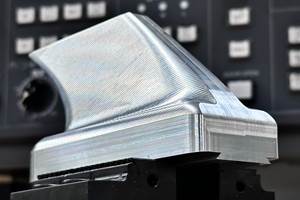Tooling Tips for Turreted Machines
Increasing the number of usable cutting tool edges is one way to make turreted machines more productive. This quad square shank holder from Eppinger Exsys enables roughing and finishing tools to be mounted in one station.
Share






The trend to turnmills, multitasking machines and other types of machine tools with driven tools on tool turrets continues to grow, so shops are paying more attention to the tooling solutions applied to these machines. As other shops catch up by investing in similar technology, users have to be sure they are getting the most productivity and best accuracy from these machines. With this in mind, Exsys Tool is showing visitors to its ooth (W-1664) how its new compensating clutch improves the performance of machine tool turret drive motors, as well helps compensate for misalignment issues and promotes better finishes while reducing the cost of perishable tooling.
The Eppinger Preci-Flex Compensating Clutch enables users to “float” away misalignment between turret drive motors and toolholders. This is accomplished by providing a floating coupling between turret drive motor tangs and toolholders that self compensates for any misalignment. This reduces vibration and tool chatter, which in turn, makes for longer tool life and better surface finishes.
The compensating clutch connection is double the size of a standard spindle, which not only provides more surface area for a strong, precise connection, but also allows for greater torque transfer and eliminates any loss of power between motors and toolholders, the company says. It also eliminates wear to turret drive motor connections because it fills the gaps at the top and bottom of drive motor tangs when engaged with the toolholder. Thus, the system provides a complete fit across the drive train of the motor to eliminate backlash while delivering much quieter operation as compared to other such systems when cutting the same workpiece materials and at the same speeds and feeds.
According to developers, the new clutch lessens the severity of damage that occurs as a result of a machine crash and reduces the cost involved with the repair. When a machine crash occurs, the result is typically a bent tool holder spindle, which can lead to costly repairs. With the compensating clutch in place, the resulting crash damage is usually confined to only the system’s coupling, which shops can easily and quickly replace themselves and at a cost that’s a lot less than having to replace an expensive spindle.
Increasing turret capacity for static toolholders is another strategy for speeding production on turret machines. Exsys is addressing this issue with its Double Square Shank and Quad Square Shank static tool holders. The double square shank holder provides for two turning inserts offset in the Y axis; so the machine can rough and finish a part in the Y axis instead of indexing to another position. For greater tool capacity, the quad square shank holder accommodates four inserts (two located on each side of the holder for complete machining in the main spindle and sub spindle). With this multiple insert capability, different types of inserts, such as those for roughing and those for finishing, can be located in the same station. This frees up other stations and eliminates having to index the machine turret to switch from one insert to the next when they are located in separate stations—therefore, saving time and money.
Related Content
How to Mitigate Risk in Your Manufacturing Process or Design
Use a Failure Mode and Effect Analysis (FMEA) form as a proactive way to evaluate a manufacturing process or design.
Read MoreCustom Workholding Principles to Live By
Workholding solutions can take on infinite forms and all would be correct to some degree. Follow these tips to help optimize custom workholding solutions.
Read More2 Secondary Coordinate Systems You Should Know
Coordinate systems tell a CNC machine where to position the cutting tool during the program’s execution for any purpose that requires the cutting tool to move.
Read More6 Variations That Kill Productivity
The act of qualifying CNC programs is largely related to eliminating variations, which can be a daunting task when you consider how many things can change from one time a job is run to the next.
Read MoreRead Next
Machine Shop MBA
Making Chips and 91±¬ÁĎÍř are teaming up for a new podcast series called Machine Shop MBA—designed to help manufacturers measure their success against the industry’s best. Through the lens of the 91±¬ÁĎÍř benchmarking program, the series explores the KPIs that set high-performing shops apart, from machine utilization and first-pass yield to employee engagement and revenue per employee.
Read MoreAMRs Are Moving Into Manufacturing: 4 Considerations for Implementation
AMRs can provide a flexible, easy-to-use automation platform so long as manufacturers choose a suitable task and prepare their facilities.
Read More




















